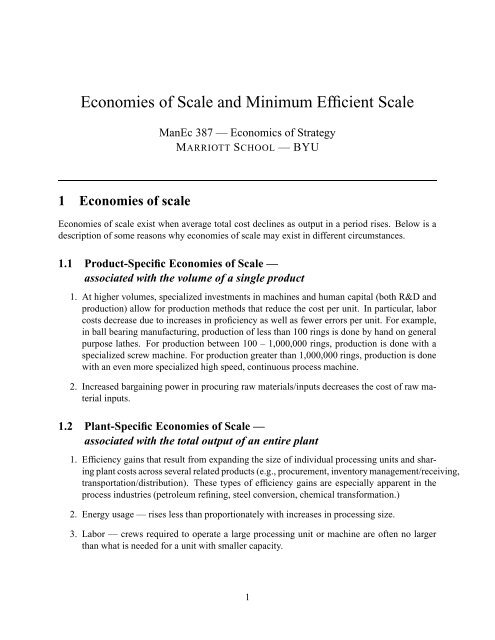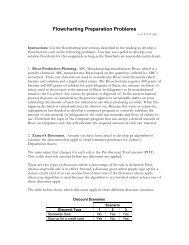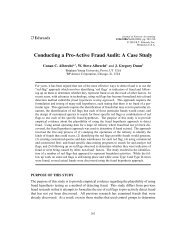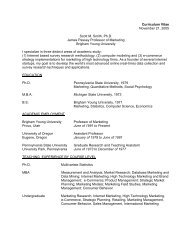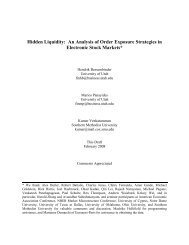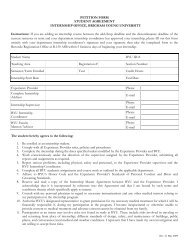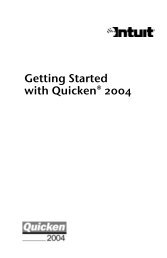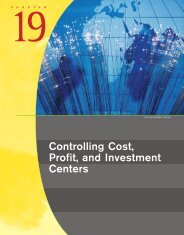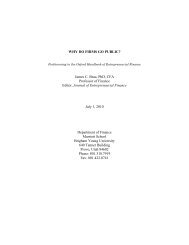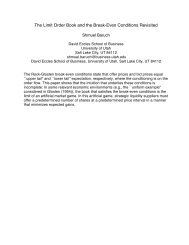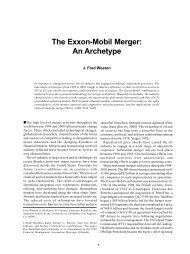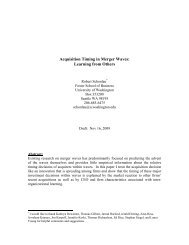Economies of Scale and Minimum Efficient Scale - Marriott School
Economies of Scale and Minimum Efficient Scale - Marriott School
Economies of Scale and Minimum Efficient Scale - Marriott School
You also want an ePaper? Increase the reach of your titles
YUMPU automatically turns print PDFs into web optimized ePapers that Google loves.
<strong>Economies</strong> <strong>of</strong> <strong>Scale</strong> <strong>and</strong> <strong>Minimum</strong> <strong>Efficient</strong> <strong>Scale</strong><br />
ManEc 387 — Economics <strong>of</strong> Strategy<br />
MARRIOTT SCHOOL — BYU<br />
1 <strong>Economies</strong> <strong>of</strong> scale<br />
<strong>Economies</strong> <strong>of</strong> scale exist when average total cost declines as output in a period rises. Below is a<br />
description <strong>of</strong> some reasons why economies <strong>of</strong> scale may exist in different circumstances.<br />
1.1 Product-Specific <strong>Economies</strong> <strong>of</strong> <strong>Scale</strong> —<br />
associated with the volume <strong>of</strong> a single product<br />
1. At higher volumes, specialized investments in machines <strong>and</strong> human capital (both R&D <strong>and</strong><br />
production) allow for production methods that reduce the cost per unit. In particular, labor<br />
costs decrease due to increases in pr<strong>of</strong>iciency as well as fewer errors per unit. For example,<br />
in ball bearing manufacturing, production <strong>of</strong> less than 100 rings is done by h<strong>and</strong> on general<br />
purpose lathes. For production between 100 – 1,000,000 rings, production is done with a<br />
specialized screw machine. For production greater than 1,000,000 rings, production is done<br />
with an even more specialized high speed, continuous process machine.<br />
2. Increased bargaining power in procuring raw materials/inputs decreases the cost <strong>of</strong> raw material<br />
inputs.<br />
1.2 Plant-Specific <strong>Economies</strong> <strong>of</strong> <strong>Scale</strong> —<br />
associated with the total output <strong>of</strong> an entire plant<br />
1. Efficiency gains that result from exp<strong>and</strong>ing the size <strong>of</strong> individual processing units <strong>and</strong> sharing<br />
plant costs across several related products (e.g., procurement, inventory management/receiving,<br />
transportation/distribution). These types <strong>of</strong> efficiency gains are especially apparent in the<br />
process industries (petroleum refining, steel conversion, chemical transformation.)<br />
2. Energy usage — rises less than proportionately with increases in processing size.<br />
3. Labor — crews required to operate a large processing unit or machine are <strong>of</strong>ten no larger<br />
than what is needed for a unit with smaller capacity.<br />
1
4. Massed reserves — lower costs for back up specialized machines (e.g. you need a back-up<br />
if you have one or five machines running). Fewer maintenance personnel are required per<br />
machine/plant; also useful when unit/machine shutdowns occur regularly <strong>and</strong> predictably.<br />
1.3 <strong>Economies</strong> <strong>of</strong> Multi-Plant Operations —<br />
associated with total corporate size<br />
1. <strong>Economies</strong> <strong>of</strong> scale in centralized service functions, such as R&D <strong>and</strong> management/staff.<br />
Costs per unit are lower by having a common central pool <strong>of</strong> researchers, financial planners,<br />
accountants, purchasing agents, lawyers, etc.<br />
2. Value <strong>of</strong> experimentation <strong>and</strong> diversity <strong>of</strong> operations wherein knowledge from one plant can<br />
be transferred to other plants. Shared production experience (best demonstrated practices)<br />
across plants can increase efficiencies.<br />
3. <strong>Economies</strong> <strong>of</strong> scale in raising capital through common stock issues <strong>and</strong> borrowing. For example,<br />
firms with $200 mm in assets borrow on average at 0.74 percentage points less than<br />
$5 mm asset firms; $1 billion asset firms borrow for 1.08 percentage points less. (1960’s;<br />
Scherer et al.) This is due to reduced variance in pr<strong>of</strong>its (lower perceived risk). The CAPM<br />
pricing model is typically used to assess risk <strong>and</strong> even one bad year <strong>of</strong> earnings is perceived<br />
as a trend. Thus, larger companies in more concentrated industries have lower Betas. Also, a<br />
firm <strong>of</strong> $500 mm assets can borrow $25 mm at close to the prime rate but if it tries to borrow<br />
$100 - 500 mm in a short time frame, it will have to pay a steep interest premium. Such capital<br />
market imperfections may contribute to concentration in capital intensive industries like<br />
steel, autos, petrol. refining, etc., requiring a very high capital investment for minimum efficient<br />
scale (MES) operation. Small competitors may have considerable difficulty financing<br />
a great leap forward in MES operation.<br />
4. <strong>Economies</strong> <strong>of</strong> scale in advertising which allow you to achieve a ”minimum threshold” <strong>of</strong><br />
advertising messages to influence the consumer; however, above the minimum threshold at<br />
some point there appears to be diminishing returns to advertising. (e.g., according to reports,<br />
some beer drinkers deluged with Budweiser ads, said, “Give me anything but a Bud.”)<br />
5. The ability to locate plants to reduce distribution/transportation costs associated with getting<br />
the product to the end user (e.g. especially with low value to bulk items or items with special<br />
distribution properties like ice, dairy products, cement, etc.)<br />
2 Diseconomies <strong>of</strong> <strong>Scale</strong><br />
For many firms, there are also observed ranges <strong>of</strong> output that exhibit diseconomies <strong>of</strong> scale. Over<br />
these ranges, average cost is rising as output increases. Diseconomies <strong>of</strong> scale put limits on scale<br />
<strong>and</strong> complicate efforts to realize the cost advantages <strong>of</strong> economies <strong>of</strong> scale. Reasons for diseconomies<br />
<strong>of</strong> scale include<br />
2
1. Diminishing returns to scale economies—with large enough volume, set-up costs dwindle to<br />
insignificance. Learning curves flatten.<br />
2. Psychological surveys show that for reasons not completely understood workers are less<br />
satisfied with jobs <strong>and</strong> challenges <strong>of</strong>fered in large plants vs. small. Therefore, to attract the<br />
required work force, you need to pay a wage premium.<br />
3. Increasing the work force in a small town may require exp<strong>and</strong>ing the geographic radius from<br />
which workers are drawn; this increases commuting costs <strong>and</strong> results in higher <strong>of</strong>fsetting<br />
wages.<br />
4. Material flows lengthen <strong>and</strong> become more complex; managing a large plant is more difficult<br />
than a small one, all things being equal. Typically, the larger the plant, the more decisions<br />
are made at higher levels by executives who are removed farther <strong>and</strong> farther from the reality<br />
<strong>of</strong> front line production.<br />
5. Transportation costs typically increase with fewer number <strong>of</strong> plants, both <strong>of</strong> materials to<br />
the plant <strong>and</strong> products to the market because they can’t be located as conveniently (only a<br />
problem with large, single plants).<br />
6. Risks <strong>of</strong> fire, explosion, wildcat strikes are at a maximum when all production is concentrated<br />
at a single plant site.<br />
3 <strong>Minimum</strong> <strong>Efficient</strong> <strong>Scale</strong><br />
With economies <strong>of</strong> scale, costs may fall over some ranges <strong>of</strong> output <strong>and</strong> rise over others. This<br />
implies that the average cost function has a minimum level <strong>of</strong> cost. The output level that delivers<br />
the lowest possible cost is called minimum efficient scale (MES). <strong>Minimum</strong> efficient scale is critical<br />
to strategic decision-making with economies <strong>of</strong> scale because it identifies the level <strong>of</strong> scale required<br />
to enjoy optimal cost savings. Firms with scale less than MES have a cost disadvantage. Often,<br />
firms with scale greater than MES also have a cost disadvantage. In some cases, the lowest average<br />
cost is attainable over a large range <strong>of</strong> output. In these cases, minimum efficient scale is the smallest<br />
level <strong>of</strong> output that can deliver the lowest cost.<br />
3
Given below are the levels <strong>of</strong> minimum efficient scale, their percentage <strong>of</strong> 1967 dem<strong>and</strong>, <strong>and</strong> the<br />
percentage <strong>of</strong> cost disadvantage incurred by firms operating at less than minimum efficient scale. 1<br />
% by which<br />
% <strong>of</strong> 1967 unit cost rises<br />
Industry <strong>Minimum</strong> <strong>Efficient</strong> <strong>Scale</strong> Dem<strong>and</strong> at 0.33 MES<br />
Beer brewing 4.5 million barrels (31 gallon) per year 3.4 5.0<br />
Cotton <strong>and</strong><br />
synthetic<br />
fabrics<br />
37.5 million sq. yards per year; 600 employees<br />
in modern integrated plants<br />
0.2 7.6<br />
Paints 10 million gallons per year; 450 employees 1.4 4.4<br />
Petroleum<br />
refining<br />
Nonrubber<br />
shoes<br />
200,000 barrels (42 gallon) per day crude oil<br />
processing<br />
1 million pairs per year; 250 employees per<br />
shift<br />
1.9 4.8<br />
0.2 1.5<br />
Integrated<br />
Steel<br />
4 million tons per year 2.6 11.0<br />
Refrigerators 800,000 units per year 14.1 6.5<br />
Automobile<br />
batteries<br />
1 million units per year; 300 employees 1.9 4.6<br />
1 Source: F.M. Scherer, Alan Beckenstein, Erich Kaufer, <strong>and</strong> R.D. Murphy, The Economics <strong>of</strong> Multi-Plant Operation:<br />
An International Comparisons Study, Harvard University Press, Cambridge, MA, 1975.<br />
4
Given below are the MES as a percentage <strong>of</strong> 1967 dem<strong>and</strong> <strong>and</strong> the percentage <strong>of</strong> cost disadvantage<br />
incurred by firms operating at less than minimum efficient scale for a variety <strong>of</strong> industries. 2<br />
MES as % <strong>of</strong> % increase in unit<br />
Industry US dem<strong>and</strong> cost at 0.25 MES<br />
Flour mills 0.7 3<br />
Soybean mills 2.4 2<br />
Bread baking 0.3 7.5<br />
Tufted rugs 0.7 10<br />
Printing paper 4.4 9<br />
Sulphuric acid 3.7 1<br />
Synthetic rubber 4.7 15<br />
Cellulosic synthetic fibers 11.1 5<br />
Nylon, acrylic, <strong>and</strong> polyester fabrics 6.0 7–11<br />
Detergents 2.4 2.5<br />
Passenger auto tires 3.8 5<br />
Bricks 0.3 25<br />
Iron foundries: lg. castings 0.3 10<br />
Turbogenerators 23.0 NA<br />
Machine tools 0.3 5<br />
Electronic computers 15.0 8<br />
Electric motors 15.0 15<br />
Transformers (mix <strong>of</strong> types) 4.9 8<br />
Integrated passenger auto production 11.0 6<br />
Commercial transport aircraft 10.0 20<br />
Bicycles 2.1 NA<br />
Diesel engines, up to 100 hp 21-30 4-28<br />
2 Source: Leonard W. Weiss, “Optimal Plant Size <strong>and</strong> the Extent <strong>of</strong> Suboptimal Capacity,” in Robert T. Masson <strong>and</strong><br />
P.D. Qualls, eds., Essays on Industrial Organization in Honor <strong>of</strong> Joe S. Bain, Ballinger, Cambridge, MA, 1975.<br />
5


